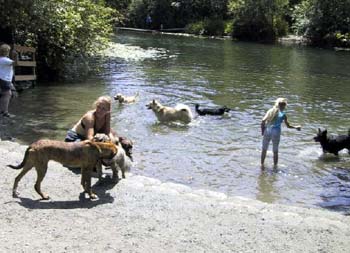Table of Contents
Featured Inuit Dog Owner: Dr. Lucien Ockovsky
The First Official ISDI Gathering
Nunavut Quest 2001 Diary
The Song of the Glacier
An Arctic "Fish Story"
Defining ISD Purity
Distemper in the North
Brucellosis in Arctic Marine Mammals: A threat to team dogs?
Poem: But, I must be dreaming, that's years ago...
Book Review: the latest Coppinger book
Janice Howls: Who Belongs in the ISDI?
Page from a Behaviour Notebook: Inuit Dog Stereotypes
Frankly Speaking: Zombies
Navigating This
Site
Index of articles by subject
Index
of back issues by volume number
Search The
Fan Hitch
Articles
to download and print
Ordering
Ken MacRury's Thesis
Our
comprehensive list of resources
Talk
to The Fan
Hitch
The Fan Hitch
home page
ISDI
home page
Editor: Sue Hamilton
Webmaster: Mark Hamilton
Contents of The Fan Hitch Website and its publications are protected by international copyright laws. No photo, drawing or text may be reproduced in any form without written consent. Webmasters please note: written consent is necessary before linking this site to yours! Please forward requests to Sue Hamilton, 55 Town Line Rd., Harwinton, Connecticut 06791, USA or mail@thefanhitch.org

Terry Miller's team of ISDs runs
side-by-side with two
other teams. Miller photo
Stereotypes of Inuit Dog
Behavior:
Where do we start, and where can we
go?
by Sylvia Feder
As a participant at the Inuit Sled Dog International (ISDI) Gathering, held this past July at Wintergreen Dogsledding Lodge in Ely, Minnesota [USA], I was struck by the differences in people's perceptions of the Inuit Sled Dog, even among those of us who have had the breed for some time. Our perceptions of our dogs are colored by our experiences and the experiences of others, and some are so ingrained as to be considered stereotypes. For example, during the round table discussion on training and working, several people expressed concern with passing other teams, implying that they were worried that their dogs might attack. This supported their perception of the breed as being aggressive, a theme that was repeated throughout the weekend. Contrast this with the experiences of this topic's discussion leaders, Scott and Terry Miller of Hinckley, Minnesota [USA], who regularly run alongside other teams and can easily pass strange teams without incident. Or consider the Greenland teams that we saw in Paul Schurke's incredible Saturday evening slide show, which run as a pack of eighteen dogs beside other teams of similar size. But I have often heard that Inuit dogs cannot be trusted around dogs of other breeds, particularly small yappy dogs or household dogs over whom they may eventually become dominant.
The perceptions certainly have some truth to them, and therein lies their significance -- the perceptions will come true if nothing is done to change them. Inuit dogs, if not trained rigorously with other teams, will be aggressive when passing. Inuit dogs who are not socialized to small yappy dogs or growly, assertive Akitas will, in all likelihood, view them as snacks or challenges, respectively. But these outcomes are not inevitable. As the Millers described at the Gathering, and have shown convincingly, Inuit dogs can be as civilized and well-behaved on the trail as any trained Siberian or Alaskan team. Hours of hard work and hundreds and hundreds of miles have created dogs that will line out beside other teams before the start of a run, run next to other teams, and do head-on or overtaking passes without even glancing at the other dogs.

Thule, a male ISD, plays with an
assortment of dogs
at
anoff-leash dog park.
Feder photo
In terms of interactions with dogs of different breeds, I realized when I moved from Alaska to Seattle that my dogs would have to become socialized in a different way. As my old team retired and I acquired new dogs, I was especially careful to socialize them as puppies to many diverse situations. In the Seattle area we are fortunate to have several off-leash "dog parks" where people, and dogs of all sizes, shapes and colors are free to wander and interact. There are fields, trails through the woods, and beaches along a river.
This is popular recreation. On a given one-hour visit, we may see fifty or more dogs. This was invaluable for teaching my pups that a tiny Jack Russell terrier is as much a dog as a Great Dane (and equally intimidating, I might add!). As they grew into adulthood, my dogs acquired what I would call good "doggy social skills." They recognize playful dogs and will engage them in games, are gentle around small dogs and puppies, ignore the Border Collie that incessantly tries to herd them, and move away casually and smoothly from that occasional obnoxious Lab, Chow, or Akita that pushes or tries to dominate them. I have been bringing my male Inuit dogs to the dog park since they were eight weeks old, and in nearly four years have never seen them display aggression or predatory behavior towards other dogs.
Now, most Inuit dog owners probably don't encounter Jack Russell terriers on their daily runs. If you live in the wilderness and don't expect to encounter other dogs, children out walking their Chihuahuas, or babies in strollers, it is less important to do this sort of socialization or rigorous training. Readers from the arctic are probably smiling at the frivolity of this whole subject. But alas, not all of us are fortunate enough to live in the arctic. My dogs and I make our home less than an hour from downtown Seattle. I suspect there are others in similar situations.
Don't limit yourself by the stereotypes of the Inuit Dog. Understand them, because that's where you have to start. Then set some realistic goals and expectations, and work hard to help your dogs meet them.